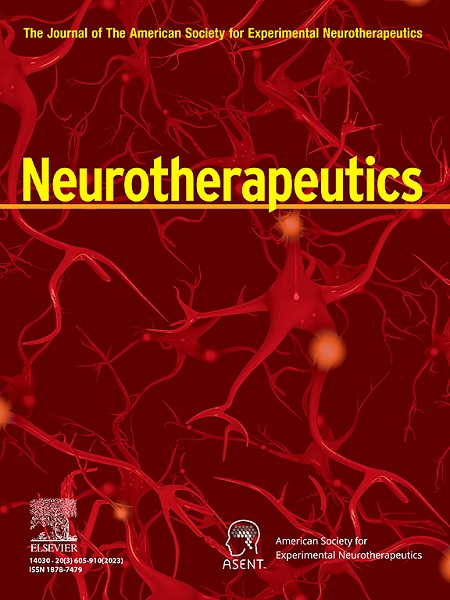小脑深部刺激作为一种双重功能疗法,可恢复肌张力障碍小鼠的运动和睡眠。
IF 5.6
2区 医学
Q1 CLINICAL NEUROLOGY
引用次数: 0
摘要
肌张力障碍伴随着小脑功能障碍而产生,小脑功能障碍在多种病理生理缺陷的出现中起着关键作用,这些缺陷包括异常运动和姿势以及睡眠紊乱。目前的治疗干预措施通常无法同时解决肌张力障碍的运动症状和非运动症状,这凸显了多功能治疗策略的必要性。深部脑刺激(DBS)可有效减轻肌张力障碍的运动症状,现有的平行证据也证明它具有纠正睡眠障碍的潜力。然而,DBS 对改善睡眠和运动功能障碍的同时疗效(特别是通过靶向小脑)仍未得到充分探索。在这里,我们在两种表现出睡眠缺陷的肌张力障碍遗传小鼠模型--Ptf1aCre;Vglut2fx/fx和Pdx1Cre;Vglut2fx/fx--中测试了小脑DBS的效果,这两种模型有重叠的小脑回路错误配线缺陷,但运动表型的严重程度不同。通过对位于小脑扣带回和间隙核之间的纤维束进行定向DBS(FN + INT-DBS),我们通过提高睡眠质量和时间来调节睡眠功能障碍。这种 DBS 范式改善了两个突变体的觉醒和快速眼动睡眠。此外,这两种模型进入快速眼动睡眠的潜伏期都缩短了,而快速眼动睡眠是在人类肌张力障碍患者身上观察到的一种缺陷。小脑去极化电刺激疗法还诱发了定义睡眠状态的皮层电图(ECoG)模式的改变。正如预期的那样,小脑去颅磁刺激减少了在Ptf1aCre;Vglut2fx/fx小鼠身上观察到的严重肌张力障碍扭转运动症状。这些发现凸显了使用小脑DBS同时改善肌张力障碍患者睡眠和减少运动功能障碍的潜力,并揭示了其作为体内双效治疗策略的潜力。本文章由计算机程序翻译,如有差异,请以英文原文为准。
Cerebellar deep brain stimulation as a dual-function therapeutic for restoring movement and sleep in dystonic mice
Dystonia arises with cerebellar dysfunction, which plays a key role in the emergence of multiple pathophysiological deficits that range from abnormal movements and postures to disrupted sleep. Current therapeutic interventions typically do not simultaneously address both the motor and non-motor symptoms of dystonia, underscoring the necessity for a multi-functional therapeutic strategy. Deep brain stimulation (DBS) is effectively used to reduce motor symptoms in dystonia, with existing parallel evidence arguing for its potential to correct sleep disturbances. However, the simultaneous efficacy of DBS for improving sleep and motor dysfunction, specifically by targeting the cerebellum, remains underexplored. Here, we test the effect of cerebellar DBS in two genetic mouse models with dystonia that exhibit sleep defects—Ptf1aCre;Vglut2fx/fx and Pdx1Cre;Vglut2fx/fx—which have overlapping cerebellar circuit miswiring defects but differing severity in motor phenotypes. By targeting DBS to the fiber tracts located between the cerebellar fastigial and the interposed nuclei (FN + INT-DBS), we modulated sleep dysfunction by enhancing sleep quality and timing. This DBS paradigm improved wakefulness and rapid eye movement sleep in both mutants. Additionally, the latency to reach REM sleep, a deficit observed in human dystonia patients, was reduced in both models. Cerebellar DBS also induced alterations in the electrocorticogram (ECoG) patterns that define sleep states. As expected, DBS reduced the severe dystonic twisting motor symptoms that are observed in the Ptf1aCre;Vglut2fx/fx mice. These findings highlight the potential for using cerebellar DBS to simultaneously improve sleep and reduce motor dysfunction in dystonia and uncover its potential as a dual-effect in vivo therapeutic strategy.
求助全文
通过发布文献求助,成功后即可免费获取论文全文。
去求助
来源期刊

Neurotherapeutics
医学-神经科学
CiteScore
11.00
自引率
3.50%
发文量
154
审稿时长
6-12 weeks
期刊介绍:
Neurotherapeutics® is the journal of the American Society for Experimental Neurotherapeutics (ASENT). Each issue provides critical reviews of an important topic relating to the treatment of neurological disorders written by international authorities.
The Journal also publishes original research articles in translational neuroscience including descriptions of cutting edge therapies that cross disciplinary lines and represent important contributions to neurotherapeutics for medical practitioners and other researchers in the field.
Neurotherapeutics ® delivers a multidisciplinary perspective on the frontiers of translational neuroscience, provides perspectives on current research and practice, and covers social and ethical as well as scientific issues.
 求助内容:
求助内容: 应助结果提醒方式:
应助结果提醒方式:


